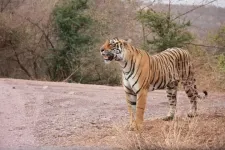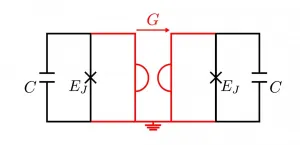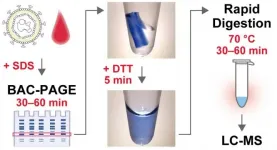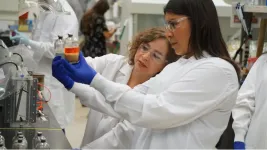New revelations of tiger genomes
Tiger genomes reveal signatures of population bottlenecks, recent divergence between subspecies, local adaptation, and ongoing impacts of fragmentation
2021-02-18
(Press-News.org) Genetic variation is like money in the bank: the more you have, the better your chances of survival in the future. Population bottlenecks decrease genetic variation, especially in endangered species. An individual's genome comprises the events that have impacted genetic variation over time, and relatively recent sequencing technologies allow us to read and interpret genetic variation across the genome. Although tigers have received significant conservation attention, little is known about their evolutionary history and genomic variation. This is especially true for Indian tigers, and with 70% of the world's tigers living in India, such understanding is critical to tiger conservation.
A team of researchers from the National Centre for Biological Sciences (NCBS), Stanford University, and zoological parks and NGOs across the world recently completed a three-year project to gain insights into genomic variation in tigers and the processes that have sculpted it. The work, just published in Molecular Biology and Evolution, reiterates that tiger subspecies are genetically distinct and reveals that although Indian tigers have the highest total genetic variation, some individuals are inbred. Simulations based on the genomic data suggest relatively recent divergences between subspecies, and intense population bottlenecks. Analyses also indicate adaptation to cold environments in Russian far east tigers, and potential selection on body size in Sumatran tigers.
The team sequenced whole genomes from 65 individual tigers from four subspecies, with a specific aim to enhance genomes from wild tigers in different habitats in India. They used these data to conduct a variety of population genomic analyses that quantify genetic variability, and investigate the partitioning of genetic variation, possible impacts of inbreeding and founder events, demographic history (including population divergence) and possible signatures of local adaptation.
They found that total genomic variation in Indian tigers was higher than in other subspecies. However, several individual tigers in India had low variation, suggesting possible inbreeding and founding bottlenecks. Tigers from northeast India were the most divergent/different from other populations in India. "Given our results, it is important to understand why some Bengal tigers appear inbred and what the consequences of this are," says Anubhab Khan, co-first author, NCBS.
The history of tiger populations from across their current range shows recent divergences between tiger subspecies, within the last 20,000 years, which is concordant with a transition from glacial to interglacial climate change and increasing human impacts across Asia. These findings are in sharp contrast to an earlier study by ShuJin Luo and others in 2018 that suggested much older divergence times. The recent divergence between populations will need to be investigated further with expanded datasets and analyses of more tiger genomes.
The data and analyses also suggest strong bottlenecks in all tiger populations, highlighting the importance of population size decline on the erosion of genetic variation. "Most studies focusing on species of conservation concern use limited numbers of specimens to try to gain understanding into how genomic variation is partitioned. It is clear from our work here, and a growing number of other studies, that it is crucial to increase our sampling efforts and use caution when interpreting results from limited sample sizes," comments Ellie Armstrong, co-first and co-corresponding author, Stanford University.
Genomes of tigers in the Russian far east suggest adaptation to the cold, while those of Sumatran tigers suggest selection based on body size. Co-senior author Elizabeth Hadly of Stanford University says, "The tiger is an excellent example of the myriad historic events that sculpt species' genomic diversity and points to the importance of understanding this diversity as we attempt to stave off extinction of our most precious species on Earth. While some populations demonstrate the importance of adaptation to local conditions, other evidence suggests that particular populations may suffer the effects of climatic change in the Anthropocene." Such information will be critical to the success of genetic rescue efforts, which should take local adaptation into consideration.
'I have worked on Indian tiger genetic variation for over a decade and always wondered how they compared to other wild tigers. Our study reveals that while the total variation in Indian tiger genomes is high, they have also been dramatically shaped by population bottlenecks. The genomic variation of Indian tigers continues to be shaped by the ongoing loss of connectivity. Population management and conservation action must incorporate information on genetic variation. I hope doing so will help India maintain the gains in tiger conservation achieved so far,' says Uma Ramakrishnan, co-senior and co-corresponding author, NCBS.
INFORMATION:
[Attachments] See images for this press release:

ELSE PRESS RELEASES FROM THIS DATE:
2021-02-18
Working with colleagues from Germany and the US, researchers at Leipzig University have achieved a breakthrough in research into how cancer cells spread. In experiments, the team of biophysicists led by Professor Josef Alfons Käs, Steffen Grosser and Jürgen Lippoldt demonstrated for the first time how cells deform in order to move in dense tumour tissues and squeeze past neighbouring cells. The researchers found that motile cells work together to fluidise tumour tissue.
Käs led the research project in cooperation with Professor Lisa Manning from Syracuse University (US) and Professor Bahriye Aktas from Leipzig University Hospital. They have now ...
2021-02-18
Building a universal quantum computer is a challenging task because of the fragility of quantum bits, or qubits for short. To deal with this problem, various types of error correction have been developed. Conventional methods do this by active correction techniques. In contrast, researchers led by Prof. David DiVincenzo from Forschungszentrum Jülich and RWTH Aachen University, together with partners from the University of Basel and QuTech Delft, have now proposed a design for a circuit with passive error correction. Such a circuit would already be inherently fault protected and could significantly accelerate the construction of a quantum computer with a large number of qubits.
In order to encode quantum information ...
2021-02-18
Mass spectrometry (MS) is a powerful method for biomarker analysis because it enables highly sensitive and accurate measurement of target molecules in clinical samples. The application of MS to clinical diagnosis, such as neonatal metabolic screening, has been progressing with a focus on metabolite markers. MS measurement of proteins is currently mainly used for novel marker discovery studies, but there is a growing interest in its application in clinical marker diagnosis as an alternative to immunoassays.
MS-based quantification of protein biomarkers is mainly performed by a bottom-up approach using peptide fragments obtained by enzymatic ...
2021-02-18
A study of over 1,700 U.S. young people exposed to four major hurricanes found that just a few of them reported chronic stress, and the trajectories among most youth reflected recovery or low-decreasing post-traumatic stress (PTS) symptoms, according to research recently published in JAMA Network Open.
Titled "Trajectories of Post-traumatic Stress in Youths After Natural Disasters," the inquiry, conducted from August 2017 to August 2020, combined data from four studies of youths ages six to 16 who attended schools near the respective destructive paths of Hurricanes Andrew (1992), Charley (2004), Ike (2005) and Katrina (2008), from three to 26 months following the disasters. Fifty-four percent of ...
2021-02-18
Ancient alchemists dreamed of transforming base materials like lead into gold and other valuable commodities. While such efforts generally came to naught, researchers today are having some success in extracting a variety of useful products like aviation fuels, lubricants, solvents, food additives and plastics from organic waste.
The trick is accomplished with the aid of specialized bacteria, whose metabolic activities can convert simpler chemicals into useful products through a microbial growth process knows as chain elongation.
Anca Delgado, a researcher in the Biodesign Swette Center for Environmental Biotechnology at Arizona State University, has been exploring the phenomenon. In a new study, she describes ...
2021-02-18
EUGENE, Ore. -- Feb. 18, 2021 -- An abnormal suppression of the immune system linked to the onset of numerous diseases has been associated with poor functional regeneration of traumatic bone injuries.
Levels of immune cells and proteins circulating in the blood following traumatic injury combined with advanced data analytics could predict whether patients are likely to respond to treatment, said Robert Guldberg, executive director of the Phil and Penny Knight Campus for Accelerating Scientific Impact.
The project -- detailed in a paper published online ahead of print in the Proceedings of the National Academy of Sciences -- identified ...
2021-02-18
WASHINGTON--A potentially dangerous side effect of testosterone therapy for transgender men is an increase in red blood cells that can raise the risk of blood clots, heart attack or stroke, according to a new study published in the Endocrine Society's Journal of Clinical Endocrinology & Metabolism.
Gender diverse people make up an estimated 0.6% of the U.S. population and are defined as having gender identity that is not aligned with their sex recorded at birth. Transgender men often undergo testosterone therapy as part of their gender-affirming treatment. Erythrocytosis, a condition where your body makes too many red blood cells, is a common side effect of testosterone therapy that can increase the risk of blood clots, heart attack or stroke.
"Erythrocytosis is common ...
2021-02-18
Despite being one of the world's most charismatic species, tigers face uncertain futures primarily due to habitat fragmentation, human-wildlife conflict and poaching. As global tiger populations decline, so does their genetic diversity. But until now it's been unclear how the animals' dwindling numbers are affecting them at the genetic level.
To find out, researchers at Stanford University, the National Centre for Biological Sciences, India, and various zoological parks and NGOs sequenced 65 genomes from four of the surviving tiger subspecies. Their findings confirmed that strong genetic differences exist between different tiger subspecies but showed, surprisingly, that these differences emerged relatively recently, ...
2021-02-18
Transit-oriented development--which concentrates high-density housing, commercial activities and public spaces around a rapid transit station--can both be a boon and a bane for communities, suggests a new UBC study.
"Transit-oriented development (TOD) can reduce traffic congestion and air pollution, encourage active mobility, and revitalize a neighbourhood," explains study author Craig E. Jones, a PhD candidate in geography and the research coordinator for the Housing Research Collaborative at UBC's faculty of applied science.
"However, it can also cause gentrification through the demolition of affordable rental housing. It can tailor the area towards condo ...
2021-02-18
PHOENIX, Ariz. and DUARTE, Calif. -- Feb. 17, 2021 -- Urinalysis has long been a staple of physical exams to detect and manage a number of diseases and disorders, but not cancer. What if it were that easy, though, and cancer was detected in its very earliest stages when the disease responds more favorably to treatment and improved outcomes are more likely?
That was the question posed by scientists at the Translational Genomics Research Institute (TGen), an affiliate of City of Hope, who have found a way of zeroing in on early-stage cancer by analyzing short strands of cell-free DNA in urine. Their study's findings were published today in the scientific journal Science ...
LAST 30 PRESS RELEASES:
[Press-News.org] New revelations of tiger genomes
Tiger genomes reveal signatures of population bottlenecks, recent divergence between subspecies, local adaptation, and ongoing impacts of fragmentation





